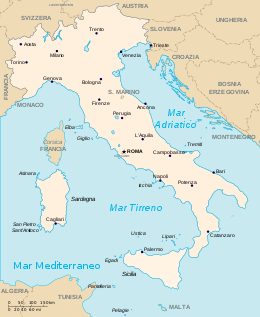 Disambiguazione – Se stai cercando altri significati, vedi Italia (disambigua).
Disambiguazione – Se stai cercando altri significati, vedi Italia (disambigua).
 Disambiguazione – "Repubblica Italiana" rimanda qui. Se stai cercando altri significati, vedi Repubblica Italiana (disambigua).
Disambiguazione – "Repubblica Italiana" rimanda qui. Se stai cercando altri significati, vedi Repubblica Italiana (disambigua).
 Italia
Italia
(details)
(details)
Italy - Localization
Italy (dark green) in the European Union (light green) Administrative dataFull nameItalian Republic Official nameItalian Republic Official languagesItalian[1] Other languagesBilingualism at a regional or local level, see list CapitalRome (2,755,309 inh. / 2022) PoliticsForm of governmentParliamentary republic unitary President of the RepublicSergio Mattarella Prime MinisterGiorgia Meloni IndependenceMarch 17, 1861 Proclamation of the Kingdom of Italy[2] ProclamationJune 18, 1946[3] Entry into the UNDecember 14, 1955 Entry into the EUMarch 25, 1957 (founding member) AreaTotal302,068.26 km² (72nd) % of water2.4% PopulationTotal58,997,201 inh. (January 1, 2023) (25th) Density195.31 inh./km² (39th) Growth rate-0.06%[4] DemonymItalians GeographyContinentEurope[5] BordersSan Marino, Vatican City, France, Switzerland, Austria, and Slovenia Time zone
EconomyCurrencyeuro GDP (nominal)$2,090,448[[6\]](https://en.wikipedia.org/wiki/Italy#cite_note-IMFWEOIT-6) million (2020 estimate) (8th) GDP per capita (nominal)$34,428[[6\]](https://en.wikipedia.org/wiki/Italy#cite_note-IMFWEOIT-6) (2020 estimate) (28th) GDP (PPP)$2,515,796[[6\]](https://en.wikipedia.org/wiki/Italy#cite_note-IMFWEOIT-6) million (2020 estimate) (12th) GDP per capita (PPP)$41,433[[6\]](https://en.wikipedia.org/wiki/Italy#cite_note-IMFWEOIT-6) (2020 estimate) (33rd) HDI (2021)0.895[[7\]](https://en.wikipedia.org/wiki/Italy#cite_note-HD_Report-7) (very high) (30th) Fertility rate1.25 (2022)[[8\]] VariousCodes ISO 3166IT, ITA, 380 TLD.it, .eu Tel. prefix+39[[9\]](https://en.wikipedia.org/wiki/Italy#cite_note-9) Car signI Driving sideRight (↓↑) National anthemThe Song of the Italians
Italy - Map
Evoluzione storicaStato precedente Regno d'Italia Modifica dati su Wikidata** ·** Manuale
Regno d'Italia Modifica dati su Wikidata** ·** Manuale
(Francesco Petrarca, Rerum Vulgarium Fragmenta, s. CXLVI)
Italy (IPA: /iˈtalja/,[[10
"]](https://en.wikipedia.org/wiki/Italy#cite_note-10) listenⓘ), officially the Italian Republic,[[
11"]] (https://en.wikipedia.org/wiki/Italy#cite_note-11) is a member state of the European Union, located in Southern and Western Europe, whose territory largely coincides with the homonymous geographical region. Italy is a parliamentary republic unitary and has a population of about 59 million inhabitants,[[
12"]] (https://en.wikipedia.org/wiki/Italy#cite_note-12) making it the third most populous state in the European Union. The capital is Rome
Delimited by the Alpine arc, Italy borders to the north, from west to east, with France, Switzerland, Austria, and Slovenia; the Italian peninsula extends into the Mediterranean Sea, surrounded by the Ligurian, Tyrrhenian, Ionian, and Adriatic Seas, and by numerous islands (the largest being Sicily and Sardinia), totaling 302,068.26 km². 13 The States of Vatican City and San Marino are enclaves of the Republic, while Campione d'Italia is an exclave of the Italian Republic and an enclave of the Swiss Confederation.
Crossroads of many civilizations, ancient Italy was unified by Rome, becoming the administrative, economic, cultural, and political center of the Roman Empire. After the fall of the Western Roman Empire, medieval Italy was subjected to invasions and dominations by barbarian populations, losing its political unity. Between the 15th and 16th century, with the spread of Humanism and the Renaissance, it became once again the cultural center of the Western world. The peninsula then experienced the Counter-Reformation, the Baroque, and Neoclassicism.


